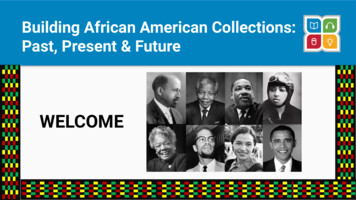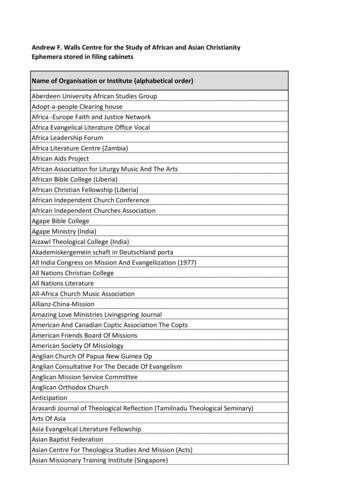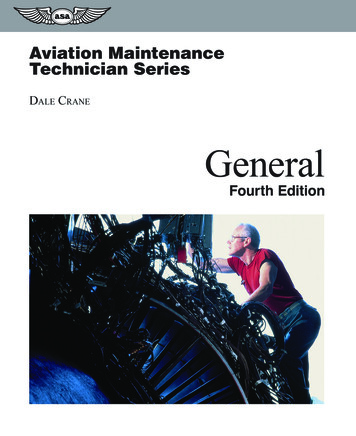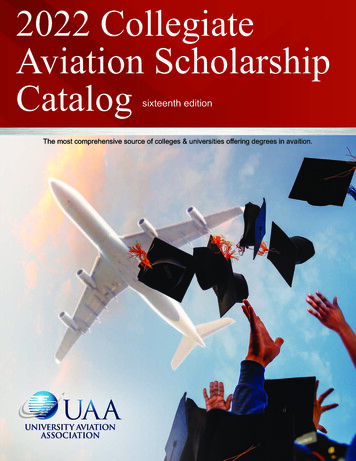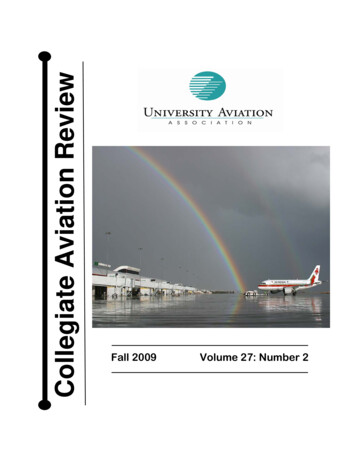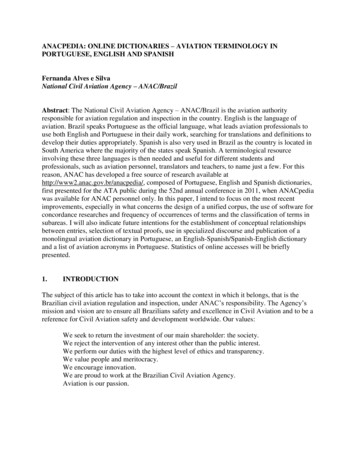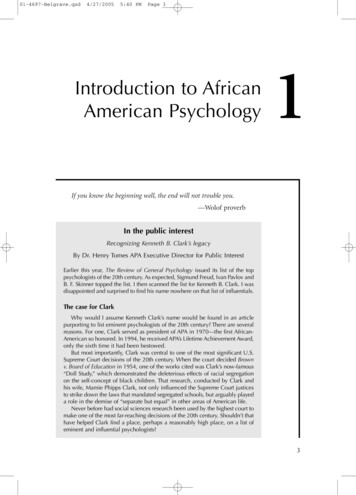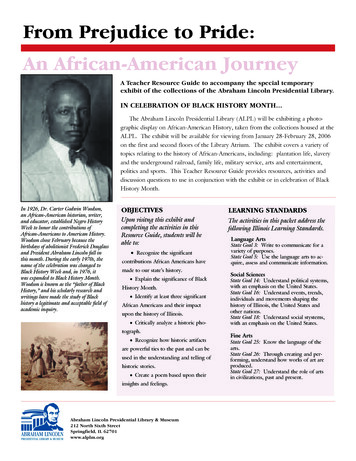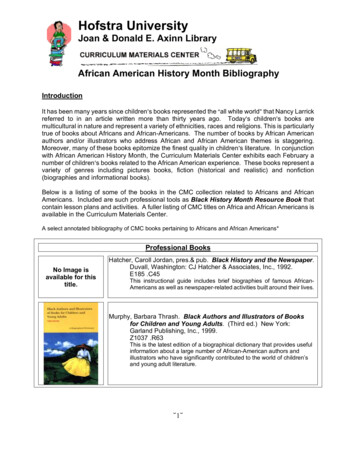
Transcription
SmithsonianNational Air and Space MuseumAfrican AmericanPioneers in Aviation1920–PresentTUSKEGEE AIRMEN ARTWORK, "THESE ARE OUR FINEST," BY ROY LAGRONEIS ON THE COVER OF THE PRINT VERSION OF THIS PUBLIC ATION.TEACHER GUIDE
This Teacher’s Guide was produced to provide educators withinformation and activities to enhance the educational content ofthe exhibition, “Black Wings: The American Black in Aviation,”and the tour, African Americans in Air and Space. To schedule agroup visit, contact the Office of Tours and Scheduling at(202) 357-1400. For more information about education programs atthe Museum, contact Educational Services, National Air and SpaceMuseum, Smithsonian Institution, Washington, D.C. 20560-0305.CREDITSPROJECT MANAGERClare Cuddy, National Air and Space MuseumRESEARCHERAlison C. MitchellWRITERLeslie O’FlahavanNATIONAL AIR AND SPACE MUSEUM ADVISORSVon D. Hardesty, Cathleen S. Lewis, Ted Robinson, curatorsEarl Brown, George (Hank) Henry, Paul Jaeger,Robert Kovalchik, Helen SomervilleTEACHER ADVISORSBarbara Adeboye, Kathleen Bragaw, Ellen Smith, Melissa Ennis,Arlington County Public Schools, Virginia; Phyllis Etzler,Fishback Creek Public Academy, Indianapolis, IndianaFIELD TESTBarbara Adeboye, Kathleen Bragaw, and their Seventh Gradestudents from Jefferson Middle School, Arlington CountyPublic Schools, VirginiaEDITORSJo HinkelDavid RomanowskiDESIGN AND PRODUCTIONGroff Creative, Inc.COVER ARTWORK“These Are Our Finest” Tuskegee Airmen Artwork by Roy LaGroneCopyright 1994 Ester S. LaGrone. All Rights Reserved.Reproduced under license from Ester S.LaGroneINSIDE COVER ARTWORK“The Magnificent Four” Tuskegee Airmen Artwork by Roy LaGroneCopyright 1994 Ester S. LaGrone. All Rights Reserved.Reproduced under license from Ester S.LaGroneACKNOWLEDGMENTSSpecial thanks to Ester S. LaGrone, Bill Mauldin and Jeanne Mauldinfor their support; and to Alison Mitchell whose research brought thisguide to life.Copyright 1999 Educational Services, National Air and SpaceMuseum, Smithsonian InstitutionThis publication is not for commercial sale. Except for individualclassroom use, no portion of this publication may be reproducedwithout written permission from the Smithsonian Institution.This publication is available online at http://www.nasm.si.edu.
ContentsTable of ContentsHOW TO USE THIS TEACHER’S GUIDE—4THE EXHIBITION AND THE TOUR—5The Exhibition — “Black Wings: The American Black in Aviation”—5The Tour — African Americans in Air and Space—6ACTIVITY 1 MEET THE PIONEERS OF BLACK AVIATION—7Biographies with photographsBessie Coleman—9William Powell—11Willa Brown—13C. Alfred “Chief” Anderson—15Benjamin O. Davis, Jr.—17ACTIVITY 2 THE WORLD WAR II ERA: OVERCOMING OBSTACLES—27ACTIVITY 3 AT THE MUSEUM: FIND A HERO AT THE“BLACK WINGS” EXHIBITION—37ACTIVITY 4 PLANNING A CAREER IN AVIATION—43Interview with Anthony Manswell, Commercial Airline Pilot—45Interview with Fred Lane, Corporate Pilot—47RESOURCES FOR TEACHERS—49CERTIFICATE OF PARTICIPATION—50Teacher Guide3
How to Use This Teacher’s GuideThis Teacher’s Guide provides activities for your students to do before, during, and after their visit to theNational Air and Space Museum. Whether you plan tovisit the exhibition, “Black Wings: The American Blackin Aviation,” or take the tour, African Americans in Airand Space, you will find this guide helpful in planningyour visit. It includes primary and secondary sourcematerials for you to photocopy and use during yourstudy of African Americans in aviation. If your studentswon’t be visiting the Museum, they can complete mostof the activities in the classroom or at airports andcultural institutions in their own community.Designed for students in Grades 5 through 9, theTeacher’s Guide includes four activities, each takingabout 50 minutes, or one class period: Activity 1 and Activity 2 are to be completed in yourclassroom before your optional visit to the Museum. Activity 3 is to be done while visiting the “BlackWings” exhibition. Activity 4 follows the visit; it is to be completed inthe classroom.You may do only a part or all of the activities in theTeachers Guide with your students. The activities aredesigned for maximum flexibility, and they allowstudents to work individually or in groups. You maycomplete some or all of the parts of each activity orgo beyond the activity to complete the extensions.How to Use This Teacher’s GuideTo book the free, hour-long tour, African Americansin Air and Space, call the National Air and SpaceMuseum’s Office of Tours and Reservations at(202) 357-1400.4Something special for your students! Included is aCertificate of Participation (see page 50) that may bephotocopied for each student participating in theactivities. The Certificate is a great way to motivate andreward your students for their efforts. You may wish todistribute the Certificates at an awards assembly or postthem in the classroom with the students’ responses tothe activities in the Guide.Teacher GuideNATIONAL EDUCATION STANDARDSADDRESSED IN THIS GUIDEInternational Reading Association/NationalCouncil of Teachers of English Standards forthe English Language Arts Students read a wide range of print and nonprint textsto build an understanding of texts, of themselves, andof the cultures of the United States and the world; toacquire new information; to respond to the needs anddemands of society and the workplace; and for personal fulfillment. Among these texts are fiction andnonfiction, classic and contemporary works. Students apply a wide range of strategies to compre-hend, interpret, evaluate, and appreciate texts. Theydraw on their prior experience, their interactions withother readers and writers, their knowledge of wordmeaning and of other texts, their word identificationstrategies, and their understanding of textual features(e.g., sound-letter correspondence, sentence structure,context, graphics). Students conduct research on issues and interests bygenerating ideas and questions, and by posing problems. They gather, evaluate, and synthesize data froma variety of sources (e.g., print and nonprint texts,artifacts, people) to communicate their discoveries inways that suit their purpose and audience. Students use a variety of technological and informa-tional resources (e.g., libraries, databases, computernetworks, video) to gather and synthesize informationand to create and communicate knowledge. Students use spoken, written, and visual language toaccomplish their own purposes (e.g., for learning,enjoyment, persuasion, and the exchange of information).
National Standards for United States Historyfrom the National Center for History in theSchools, University of California, Los Angeles Formulate historical questions.Standard 1: Chronological Thinking Interrogate historical data. Reconstruct patterns of historical successionand duration.Standard 4. Historical Research Capabilities Obtain historical data.Standard 5. Historical Issues-Analysis andDecision MakingStandard 2. Historical Comprehension Identify issues and problems in the past. Reconstruct the literal meaning of a historical passage. Marshal evidence of antecedent circumstances and Identify the central question(s) the historicalnarrative addresses. Read historical narratives imaginatively. Draw upon visual, literary, and musical sources.Standard 3. Historical Analysis and Interpretation Identify the author or source of the historicaldocument or narrative. Compare and contrast differing sets of ideas, values,personalities, behaviors, and institutions.contemporary factors contributing to problems andalternative courses of action.Career Readiness Content Standards fromthe Center for the Education and Study ofDiverse PopulationsStandard 1. Students will identify their career interestsand aptitudes to develop an educational plan whichsupports career goals.Standard 2. Students will demonstrate the technologicalknowledge and skills required for future careers.The Exhibition and the TourThe term, black aviation, describes a historical fact: Forthe first half century of powered flight, blacks flew insegregated circumstances. The story of black aviation isone of breakthroughs against restrictions. First, suchisolated pioneers as Bessie Coleman overcame theentrenched discrimination of the time. Coleman’s briefcareer as a stunt pilot inspired a generation of blackyouth. Even so, at the time of Lindbergh’s historic flightto Paris in 1927, only a few blacks had become aviators.Racial prejudice excluded most.In the 1930s African Americans formed flying clubs topromote aviation in the black community. The clubsmade it possible for African Americans to participate inaviation: Their members trained pilots and mechanicsand promoted aviation through publications, lectures,and even air “circuses.” These air shows drew thecurious with promises of “aerial acrobatics, rolls, turns,spins, ribbon cutting, crazy flying.” During 1933-34 thelong-distance flights of C. Alfred Anderson and Dr.Albert E. Forsythe displayed both flyers’ skills whileappealing for equality in aviation. In Los AngelesWilliam J. Powell set up the Bessie Coleman Aero Cluband wrote his visionary book Black Wings, which urgedblack youth to choose careers in aviation. In ChicagoCornelius R. Coffey established the Coffey School ofAeronautics, served as the first president of theThe Exhibition and the TourTHE EXHIBITION — “BLACK WINGS:THE AMERICAN BLACK IN AVIATION”5Teacher Guide
National Airmen’s Association, and built an airstrip inan African American community. Both Powell andCoffey recognized that blacks would need technicalskills to advance in aviation.In 1939 the Chicago flyers, with the help of theNational Association for the Advancement of ColoredPeople (NAACP), spurred the federal government tooffer aviation training programs for blacks. Congresshad established the Civilian Pilot Training (CPT)program to train pilots for a wartime emergency, andnow for the first time African Americans received flighttraining at federally funded CPT schools. Despite themodest budget allocated for the segregated black training program, the number of licensed black pilots grewdramatically.The Exhibition and the TourWhen the U.S. Army Air Corps activated the 99thFighter Squadron in 1942, blacks achieved their firstfoothold in military aviation. Civil rights leaders longhad called for integrating African Americans into theAir Corps, but the War Department continued to resist.When black cadets trained at the newly establishedTuskegee Army Airfield, they flew as part of a separateblack air force. Between 1941 and 1945, the Tuskegeeairmen proved that blacks could be trained andmobilized for the sophisticated task of combat flying.In World War II, the 99th Fighter Squadron and threeother all-black fighter units composed the 332d FighterGroup. These units demonstrated that the decision totrain African American flyers had been a good one.The 332d’s commander, Col. Benjamin O. Davis, Jr.,stressed professionalism and combat efficiency. Hisleadership helped eliminate hostility toward blacks’participation. Black airmen, returning from the warwith a sense of accomplishment, were impatient withthe segregation they had experienced both overseasand at home.6The Tuskegee Airmen forever shattered the myth thatblacks lacked the technical skills for combat flying. Thewar years had exposed the cost and inefficiency ofmaintaining separate black air units. In 1948 PresidentHarry S Truman’s Executive Order 9981 called forequal opportunity in the armed forces. In 1949 the AirForce became the first armed service to integrate.Teacher GuideVery slowly, civilian aviation followed suit. In the1960s African Americans were hired and promoted topositions of responsibility in commercial aviation. In1965 Marlon D. Greene won a long court battle withContinental Airlines over his right to a job as a commercial pilot. As a result of this important case, blacksbegan to break down racial barriers in the airlineindustry. In the late 1960s blacks entered the ranksof the space program.The most recent generation of black aviators hasgarnered many firsts: Daniel “Chappie” James, Jr., thefirst black four-star general; Dr. Guion Bluford, Jr., firstAfrican American to go into space; Mae Jemison, thefirst black woman astronaut; and Patrice ClarkeWashington, the first black female captain to fly for amajor airline.Nonetheless, progress has been slow, and blacks are stillunderrepresented in the aviation industry. But with legalobstacles removed, and their participation increasing,today’s flyers could make a reality of William Powell’svision—“to fill the air with black wings.”THE TOUR — AFRICAN AMERICANS IN AIRAND SPACEThe Museum’s Docent-led tour expands upon the“Black Wings” exhibition to include other objects,models, and aircraft in the collections. Students willvisit the World War I gallery to hear about EugeneBullard, who flew for the French on the Western Front;the World War II gallery to see a P-51 aircraft, typicalof the those flown by the Tuskegee Airmen; the Apollo 11Lunar Lander, where the camera designed by George R.Carruthers is displayed; and Space Hall to hear aboutthe pioneering African American astronauts.
Activity 1Meet the Pioneers of Black AviationTIME REQUIRED: ONE TO TWO CLASS PERIODSOVERVIEWPROCEDUREThis activity encourages students to explore informationbased on primary and secondary source materials,including first-person accounts, newspaper articles, andarchival photographs, a process that will aid students inanswering the following questions: Who were the blackaviators who set the stage? What challenges did theyface as they tried to participate in aviation? How didthey overcome these challenges?1. Introduce the topic of black wings by showingstudents the Chicago Defender cartoon about BessieColeman, “They Can’t Keep Us Down.”Students will identify four major challenges faced byAfrican Americans as they created their own opportunities in the field of aviation during the 1920s, 1930s, and1940s. Students will list strategies that blacks used toovercome obstacles to their participation.BACKGROUND INFORMATIONThis Teacher’s Guide includes brief biographies of fivepioneering aviators: Bessie Coleman, William J. Powell,Willa Brown, C. Alfred “Chief ” Anderson, andBenjamin O. Davis, Jr. Each biography begins with aquotation that expresses, in the subject’s own words,a defining philosophy in the struggle for black wings.PREPARATIONMake copies of the following materials for students: The five biographies The Chicago Defender cartoon about BessieColeman, “They Can’t Keep Us Down” Four primary/secondary sources from the “Reflectionand Discussion” section of Activity 1: (1) article entitled, “Aviatrix Must Sign Life Away To Learn Trade”;(2) photo of billboard reading “Colored Air Circus”;(3) publicity flyer for Black Wings, “One Million Jobsfor Negroes”; (4) Letter of December 21, 1942, toDr. William H. Hastie, civilian aide to the Secretaryof War, from Gilbert A. Cargill3. Distribute copies of the five biographies.4. Have students read the biographies. Either have eachstudent read all five biographies or group studentsand have each group read one biography.5. Students will then complete the “OvercomingObstacles” worksheet to help them understand theobstacles faced by African Americans as they becameinvolved in aviation and how they overcame thoseobstacles. You can present the “OvercomingObstacles” worksheet as a handout or copy it onthe board.REFLECTION AND DISCUSSION1. Distribute copies of these primary and secondarysources: “Aviatrix Must Sign Life Away to Learn Trade,”Chicago Defender, October 8, 1921 “One Million Jobs for Negroes,” publicity flyer forWilliam Powell’s 1934 book, Black Wings Photo of Hubert Julian pointing to a billboardannouncing the 1931 Los Angeles air show: “ColoredAir Circus” Letter to Dr. William H. Hastie from Gilbert A.Cargill, December 21, 1942Teacher GuideMeet the Pioneers of Black AviationOBJECTIVES2. Tell students that the cartoon is from 1921 and thatit was published in the Chicago Defender, one of thenation’s most influential African American newspapers. As a class, have students analyze the cartoon:What did aviation mean to the black community?Why do you think aviation had this meaning atthis time?7
2. Discuss the items as a class. Focus the discussion onthe following question: How do these primary sourcematerials illustrate the ideas that you recorded in the“Overcoming Obstacles” handout?EXTENSIONS1. Read Willa Brown’s December 6, 1941 letter to FirstLady Eleanor Roosevelt. The third paragraph of theletter mentions the difficulties Willa Brown has faced.In Brown’s voice, write a diary entry discussing yourdifficulties and how they make you feel.2. Dramatize a meeting between Eleanor Roosevelt andWilla Brown. When they met, what did they discuss?How did they speak to each other? Record theirconversation.3. In the voice of an aviator whose biography you read,write a diary entry in which you discuss yourdifficulties and successes in your efforts to becomean aviator.Meet the Pioneers of Black Aviation4. Write about a situation in which you encountereddifficulties doing something you really wanted to do.What did you do to overcome the difficulties? Whatdid you learn about yourself?8Curtiss JN-4 “Jenny” (NASM) The type of aircraft owned byBessie Coleman.Teacher Guide5. Do an original portrait of one of the aviators thatillustrates that individual’s particular power, role, orinfluence on early black aviation.6. Create a collage about early African Americanaviation. Give the collage a theme or title. Photocopythe images in this Guide; enlarge or alter them to fitthe theme of the collage. Assemble the collage—color, paint, cut the images, and position them to suitthe theme.7. Use students’ responses to the “OvercomingObstacles’’ handout to create a class poster or displayabout the strengths shown by the African Americansin the early years of aviation.CURRICULUM CONNECTIONS Social Studies: American history, civil rights,interpreting historical sources Language Arts: creative writing, reading Visual Arts: interpreting historical events in avisual medium
Activity 1: BIOGRAPHIES — BESSIE COLEMANIn 1921 Bessie Coleman became the first licensed black pilot in the United States. She received her training in France,because no American flight school would admit her. She died in 1926 at the age of 33 during a test flight for an airshow. She was a passenger in the aircraft. (NASM)9
Bessie Coleman“If I can create the minimum of my plans and desires there shall be no regrets.”—Bessie ColemanBessie Coleman’s sister, Elois Patterson, wrote “Brave Bessie,” an article about heradventurous sister. It has been excerpted here.“Bessie Coleman was called ‘Brave Bessie’ because she had fearlessly taken to the air whenaviation was a greater risk than it is today and when few men had been able to muster suchcourage. An avid reader, Bessie was well informed on what the Negro was doing and what hehad done. Given the opportunity, she knew he could become as efficient in aviation as anyone.She toyed with the idea of learning to fly, even displayed an airplane made by a Negro boy inthe window of the barber shop in which she was a manicurist. She was refused by each aviationschool to which she applied, sometimes because of her race and sometimes because she wasboth a Negro and a woman. She took her quest to Robert S. Abbott, a founder, editor, andpublisher of the Chicago Weekly Defender. He advised her to study French and Bessie promptlyenrolled in a language school in Chicago’s Loop. That accomplished, he assisted her in contacting an accredited aviation school in France. She planned to obtain certification and return to theUnited States to open an aviation training school for young blacks.“Bessie made two trips to Europe, returning to Chicago from the second one in 1922.holderof a certificate from the FAI [Federation Aeronautique Internationale, the flying school thatissued Bessie’s license]. She put on an air exhibition in 1922 at Checkerboard Field, todayknown as Midway Airport, Chicago, after which she received many calls from young Negromen, anxious to learn to fly. Bessie had obtained her certificate at great personal expense andsacrifice. She told prospective students that they had to wait until either some forward-thinkingblacks opened a training school or until Bessie herself could give enough demonstrations andaccrue sufficient money to undertake opening a school herself.“Bessie barnstormed across the country and undertook a rigorous program of speakingengagements. When Bessie appeared over the town in which she was reared, Waxahachie,Texas, she was permitted to use the university grounds of the whites for her exhibition flying.She refused to exhibit unless her people were allowed into the grounds through the frontentrance, although they were separated once inside the grounds. She decided to make anall-out effort to establish a school where she could train young Negro men to fly.“I remember one letter she wrote me saying she had taken an escort, and even went to a poolroom, so determined was she to have Negro men become air-minded. The very last letter that Ireceived from her said, ‘I am right on the threshold of opening a school.’”10
Heavyweight boxing champion Joe Louis (second from left) visits William J. Powell (right) at the workshop of the Bessie Coleman Aero Club in Los Angeles. (NASM)Activity 1: BIOGRAPHIES — WILLIAM J. POWELL11
William J. Powell“There is a better job and a better future in aviation for Negroes than in any other industry, andthe reason is this: aviation is just beginning its period of growth, and if we get into it now, whileit is still uncrowded, we can grow as aviation grows.”—William J. Powell, Black Wingsorn in 1897, William J. Powell earned an engineering degree from the University of Illinois. InB1917 he enlisted in officer training school and served in a segregated unit during World War I.During the war Powell was gassed by the enemy, and he suffered health problems throughout his lifefrom this poison gas attack.After the war Powell opened service stations in Chicago. He became interested in aviation, but theonly school that would train him was located in Los Angeles. Thus, he sold his businesses in Chicagoand moved to the West Coast. After learning to fly, Powell dreamed of opening an all-black flight school.By the 1930s Los Angeles had become an important center for black aviation. Powell organized theBessie Coleman Aero Club to promote aviation awareness in the black community. On Labor Day 1931the flying club sponsored the first all-black air show held in the United States, an event that attracted anestimated 15,000 spectators. Through the efforts of the Bessie Coleman School, the number of blackaviators increased dramatically despite the economic hardships of the Great Depression.William Powell used many methods to attract African Americans to the field of aviation. He made afilm about a young man who wanted to be a flyer, and for two years he published the CraftsmenAero-News, a monthly journal about black aviation. He offered scholarships with free technical trainingin aeronautics for black youth. He invited celebrities, such as jazz musician Duke Ellington and boxerJoe Louis, to lend their names — and their funds — to his cause.Powell published Black Wings in 1934. Dedicated to Bessie Coleman, the book entreated black menand women “to fill the air with black wings.” A visionary supporter of aviation, Powell urged blackyouth to carve out their own destiny — to become pilots, aircraft designers, and business leaders in thefield of aviation.12
Willa Brown, pilot and president of the National Airmen’s Association of America. In 1939, Willa B. Brown successfully lobbied for federal funds to support theNational Airmen’s Association pilot training program. Located in Chicago, this was the first privately-run training school for black pilots in the country.(Photographs and Prints Division, Schomburg Center for Research in Black Culture,The New York Public Library, Astor, Lenox and Tilden Foundations.)Activity 1: BIOGRAPHIES — WILLA BROWN13
Willa Brown“During the past three years I have devoted full time to aviation, and for the most part markedprogress has been made. I have, however, encountered several difficulties — several of them I havehandled very well, and some have been far too great for me to master.”—Willa Brown, in a letter to Eleanor Roosevelt, December 6, 1941Willa Brown, seeking advance publicity for a black air show, talked with Enoch Waters, the cityeditor of the Chicago Defender, an influential black owned and operated newspaper. Mr. Waters’saccount of her visit and the subsequent air show were reported to Defender readers as follows.“Willa Brown Visits the Chicago Defender”“When Willa Brown, a young woman wearing white jodhpurs, jacket and boots, strode into our newsroom in 1936, she made such a stunning appearance that all the typewriters, which had been clackingnoisily, suddenly went silent. Unlike most first-time visitors, she wasn’t at all bewildered. She had aconfident bearing and there was an undercurrent of determination in her voice.“‘I want to speak to Mr. Enoch Waters,’ she said. I wasn’t unhappy at the prospect of discoveringwho she was and what she wanted. I had an idea she was a model representing a new commercial productthat she had been hired to promote. ‘I’m Willa Brown,’ she informed me, seating herself withoutbeing asked.“In a businesslike manner she explained that she was an aviatrix and wanted some publicity for aNegro air show at Harlem Airport on the city’s southwest side. Except for the colorful ‘Colonel’ HubertFauntleroy Julian, who called himself the ‘Black Eagle’ and who had gained lots of publicity for hisexploits, and ‘Colonel’ John Robinson, a Chicago flyer who was in Ethiopia heading up Haile Selassie’sair force, I was unaware of any other Negro aviators, particularly in Chicago.“‘There are about thirty of us,’ she informed me,‘both men and women.’ Most were students, sheadded, but several had obtained their licenses and one, Cornelius Coffey, was an expert aviation andengine mechanic who also held a commercial pilot’s license and was a certified flight instructor. He wasthe leader of the group. She informed me that she held a limited commercial pilot’s license.“Fascinated by both her and the idea of Negro aviators, I decided to follow up the story myself.Accompanied by a photographer, I covered the air show. About 200 or 300 other spectators attended,attracted by the story in the Defender. So happy was Willa over our appearance that she offered to takeme up for a free ride. She was piloting a Piper Cub, which seemed to me, accustomed as I was to commercial planes, to be a rather frail craft. It was a thrilling experience, and the maneuvers — figure eights,flip-overs and stalls — were exhilarating, though momentarily frightening. I wasn’t convinced of hercompetence until we landed smoothly.”14
Activity 1: BIOGRAPHIES — C. ALFRED“CHIEF” ANDERSONAs First Lady, Eleanor Roosevelt took a special interest in the Tuskegee flight program. On a visit to the flying school,she joined C. Alfred “Chief” Anderson on an airplane ride over the facility. Her willingness to fly with a black pilot hadsymbolic value for the entire Tuskegee program. (NASM)15
C. Alfred “Chief ” Anderson“She told me, ‘I always heard Negroes couldn’t fly and I wondered if you’d mind taking me up.’ Allher escorts got tremendously upset and told her she shouldn’t do it . When we came back, shesaid, ‘Well, you can fly all right.’ I’m positive that when she went home, she said, ‘Franklin, I flewwith those boys down there, and you’re going to have to do something about it.’”—C. Alfred Anderson, A-Train: Memoirs of a Tuskegee AirmanC.Alfred “Chief ” Anderson is often called the “Father of Black Aviation,” because he spent at leastsix decades training and mentoring countless African American aviators. Interested in flying froma young age, he saved enough money by the time he was twenty to take flying lessons, but could notfind a school that would accept a black student. With his savings and some borrowed money, he boughthis own plane and begged for lessons from any pilot who would listen. He finally found an instructor inErnest Buehl, a German World War I pilot who had emigrated to the United States. Anderson earned hisPrivate Pilot Certificate in 1929, and in 1932 he became the first black to receive his Transport License.He became friends with Dr. Albert E. Forsythe and taught Forsythe to fly. Together, in 1934, they werethe first black pilots to make a round-trip continental flight.In 1939 Anderson initiated the Civilian Pilot Training (CPT) program at Howard University. Soon hewas hired to be the first African American pilot instructor at Tuskegee Institute in Alabama, which hadthe largest CPT program for blacks.He was an inspiring instructor. Although many thought it couldn’t be done, “Chief ” created expertpilots at Tuskegee. As the chief civilian flight instructor at Tuskegee, Anderson trained BenjaminO. Davis, Jr., and Daniel “Chappie” James. He was known and loved by the thousands of pilots hetrained during his 53 years as an instructor.The most famous photograph of “Chief ” Anderson shows him smiling from the cockpit of his plane,as a beaming Eleanor Roosevelt sits behind him. The photograph was taken in 1941 during Mrs.Roosevelt’s fact-finding trip to Tuskegee. As First Lady, Mrs. Roosevelt did much to promote the causeof equal opportunity for black Americans. Over the Secret Service’s objections, she flew with Andersonto show her support for the Tuskegee program. According to Anderson, the Army Air Corps begantraining blacks several days after Mrs. Roosevelt’s flight.16
Activity 1: BIOGRAPHIES — BENJAMIN O. DAVIS, JR.The first group of black cadet
Contents Teacher Guide Table of Contents HOW TO USE THIS TEACHER'S GUIDE —4 THE EXHIBITION AND THE TOUR—5 The Exhibition—"Black Wings: The American Black in Aviation"—5 The Tour—African Americans in Air and Space —6 ACTIVITY1 MEET THE PIONEERS OF BLACK AVIATION—7 Biographies with photographs
